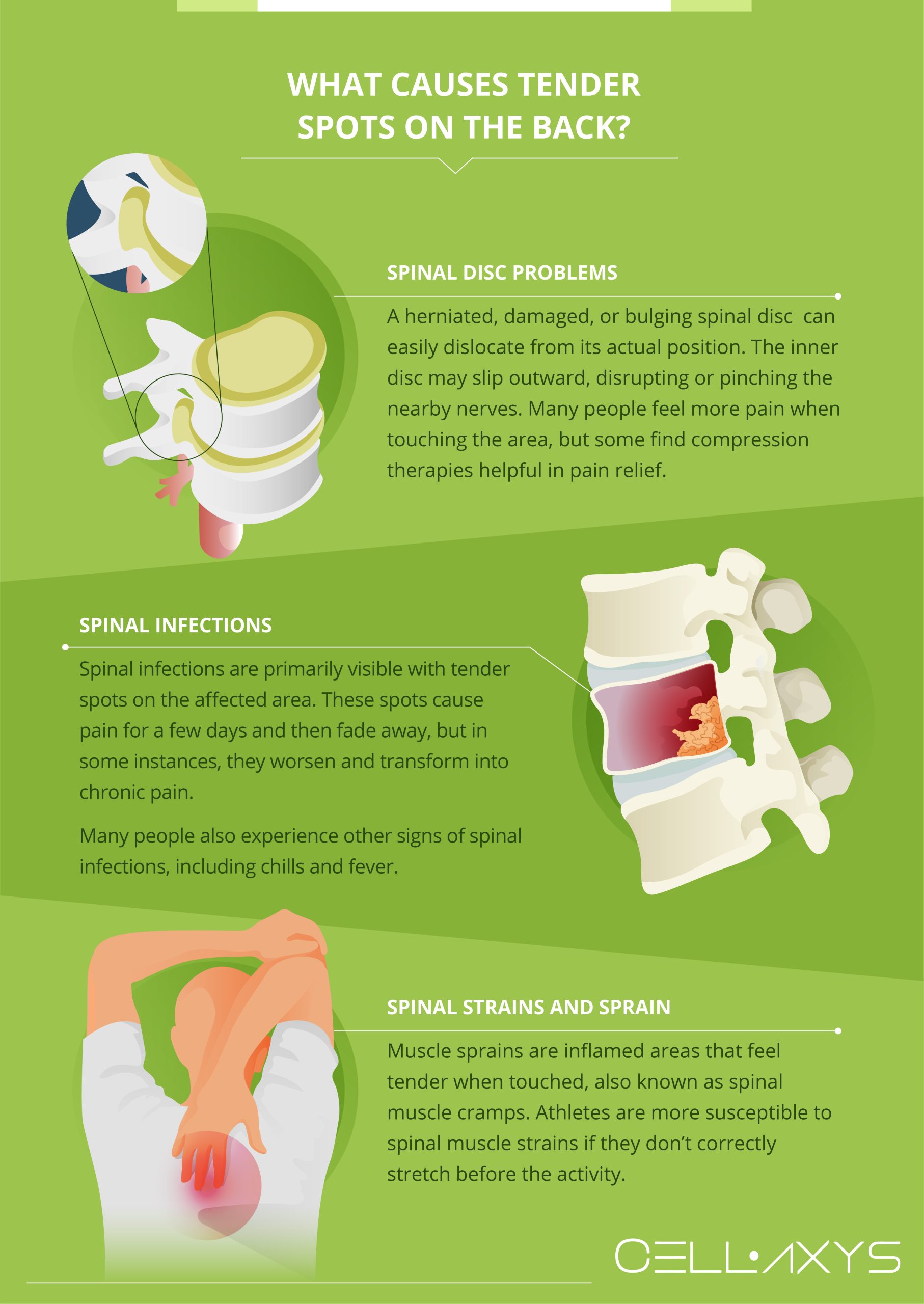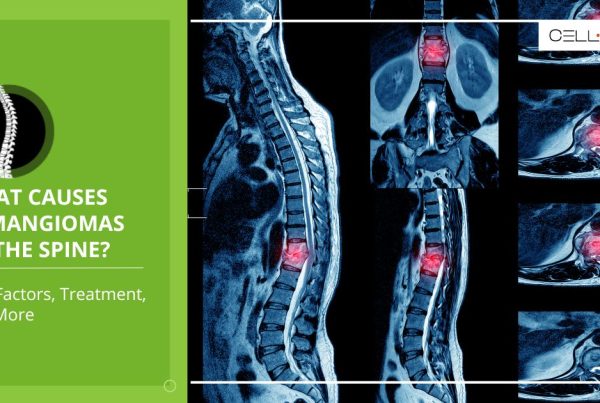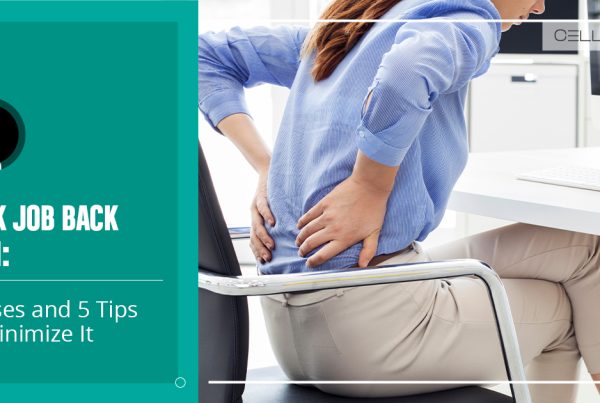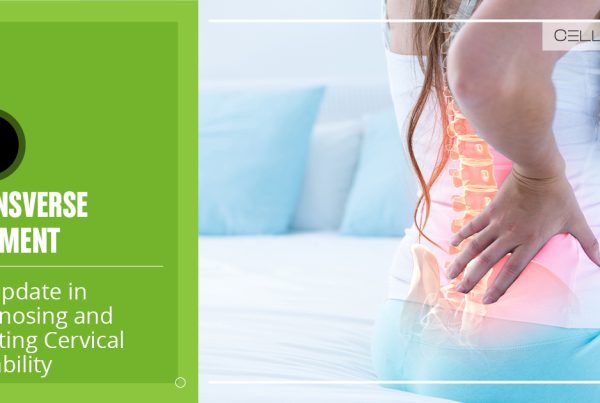Published on: September 5, 2022 | Updated on: August 29, 2024
A tender spot on the spine refers to one or more red areas on your back that cause pain when pressed. These vague spots are associated with multiple reasons, including spinal infections, muscle strains, or pinched nerves.
The treatment of tender spots on the spine varies according to their cause. Depending on the intensity and position of your tender spots, your healthcare provider may suggest different healing methods. These include modifying activities, non-surgical decompression techniques, or cell-based therapies.
What Causes Tender Spots on the Back?

Many internal and external factors can cause tender spots on your back. The most common factors of a tender spot on the spine when pressed are:
Spinal Disc Problems
If you feel pain in your spinal column, you’re likely to have a herniated, damaged, or bulging spinal disc. In such a condition, spinal discs can easily dislocate from their actual positions. The inner disc may slip outward, disrupting or pinching the nearby nerves.
As a result, a tender spot may develop at that place, particularly noticeable when you apply pressure to it. Many people feel more pain when touching the area, but some find compression therapies helpful in pain relief.
Spinal Infections
Spinal infections are primarily visible with tender spots on the affected area. These spots cause pain for a few days and then fade away, but in some instances, they worsen and transform into chronic pain. Many people also experience other signs of spinal infections and tender spots, including chills and fever.
If you had spinal surgery a few days back and observe the signs of infection, consult your healthcare professional immediately. Early intervention can prevent the disease from getting severe.
Spinal Strains and Sprain
When your muscles or tendons get strained, it results in tender spots on or around your spine. Muscle sprains are inflamed areas that feel tender when touched, also known as spinal muscle cramps. Athletes are more susceptible to spinal muscle strains if they don’t correctly stretch before the activity.
Most muscle strains can easily be treated with rest and physical therapy. However, never ignore your spinal pain, as doing so can increase the risks of muscle tears.
If the tenderness persists, your healthcare professional will suggest another treatment.
Treatment for Tender Spots on Spine
Isolated spinal tenderness disappears within a few days of rest, icing, and heat application. However, your doctor may suggest different treatment options if these methods don’t work.
Non-Surgical Decompression Techniques
Non-surgical decompression therapy presses the affected parts of your spine to promote healing cells. A healthcare provider usually uses a motorized table and harness that causes a spinal distraction by pulling the upper and lower back. This gives your spine an effective traction force to heal several spasms and strains.
Massage Therapy or Chiropractic Manipulation
Chiropractic manipulation or care is an effective musculoskeletal pain-relieving massage therapy. Massage therapy targets the tender spot on the spine when pressed and relieves muscle stiffness and tension near the spine and other joints.
During the massage therapy session, chiropractic manipulation aims to adjust your spine and joints to optimal positions.
Modifying Activities
Mild back pain or tender spots on the spine can heal with a proper exercise routine consisting of several modifying activities. These exercises help alleviate the causes of back pain, primarily muscle stiffness and spasms. Most are stretching activities that encourage your spine to become more active.
Some of the best modifying activities for tender spots on the spine include:
- Back flexion exercise
- Knee to chest stretch
- Chin to chest stretch
- Ear-to-shoulder stretch
- Hip stretch
Over-the-Counter or Prescription Anti-Inflammatory Drugs
Mainly, a tender spot on the spine, when pressed, indicates inflammation near your spinal area. This is why doctors suggest over-the-counter (OTC) medications and prescribe anti-inflammatory drugs to combat spinal infections and pain.
OTC drugs are usually recommended before the prescription for the treatment of spinal stenosis. It is the condition where the spaces within your spine narrow down, pressuring the nerves traveling through the spine. Spinal stenosis may give rise to tender spots.
OTC medications primarily alleviate inflammation and pain. These include analgesics, such as:
- Acetaminophen (e.g., Tylenol)
- Aspirin
- Ibuprofen (e.g., Motrin, Advil)
- Naproxen (e.g., Aleve)
Analgesics that relieve pain and inflammation simultaneously are known as non-steroidal anti-inflammatory drugs (NSAIDs). Your doctor may also prescribe prescription-strength NSAIDs, such as Celecoxib (Celebrex), to control spinal stenosis pain.
Stem Cell Therapy and Platelet-rich Plasma Therapy
Cell therapies focus on replacing your “autologous” (own) tissues or cells with new, healthy ones. The doctor generally recommends one of two types of stem cell therapy, including:
- Minimally Manipulated Adipose Tissue Transplant (MMAT). This procedure includes the transplantation of adipose tissues to reconstruct different areas. MMAT can involve transplanting multiple locations, which can be easily performed using the same method.
- Bone Marrow Concentrate (BMAC). This method replaces the affected cells from your bone marrow.
Stem cell therapy takes about 1.5-2 hours to complete, and you’ll go home after the procedure.
Platelet Rich Plasma (PRP) therapy aims to stimulate the growth of new and healthy tissues. This “orthobiologic procedure” has been used to treat orthopedic and spine-related injuries in sports, orthopedic, and spine medicine.
PRP procedures are usually completed within 45 minutes.
How Long Does it Take to Recover From a Spine-related Issue?
The recovery time of spine-related injuries may vary depending on the severity and level of the condition. Your efforts and lifestyle also play a significant role in speeding up your prognosis. Your doctor may not give you an exact recovery duration right away, but the fastest recovery time for spine issues has been recorded at six months.
Some people may take more time and recover in one to two years. Make sure you keep your doctor informed about your improvements and the medications you’re taking. This will prevent your doctor from suggesting any OTC or prescribed drug that may cause drug interactions.
An expert physical therapist can make a massive difference in shortening your recovery time. So, work with a professional therapist and practice a healthy lifestyle to heal quicker.
Sources
Footnotes
- Shadwell C. TENDER SPOTS ON THE SPINE IN RELATION TO PAIN IN VARIOUS PARTS OF THE BODY. The Lancet. 1904;164(4228):754-5.
- Adams MA, Roughley PJ. What is intervertebral disc degeneration, and what causes it?. Spine. 2006;31(18):2151-61.
- Daniel DM. Non-surgical spinal decompression therapy: does the scientific literature support efficacy claims made in the advertising media? Chiropractic & Osteopathy. 2007;15:7.
- Gevers-Montoro C, Provencher B, Descarreaux M, Ortega de Mues A, Piché M. Neurophysiological mechanisms of chiropractic spinal manipulation for spine pain. European journal of pain : EJP. 2021;25(7):1429-1448.
References
- All About Spinal Disc Problems. Spine-Health. Accessed 9/17/2023.
- Spinal Infection. Stanford Medicine. Accessed 9/17/2023.
- Spinal Pain. American Association of Neurological Surgeons. Accessed 9/17/2023.
CELLAXYS does not offer Stem Cell Therapy as a cure for any medical condition. No statements or treatments presented by Cellaxys have been evaluated or approved by the Food and Drug Administration (FDA). This site contains no medical advice. All statements and opinions are provided for educational and informational purposes only.
Dr Pouya Mohajer
Author
Pouya Mohajer, M.D. is the Director of Spine and Interventional Medicine for CELLAXYS: Age, Regenerative, and Interventional Medicine Centers. He has over 20 years of experience in pain management, perioperative medicine, and anesthesiology. Dr. Mohajer founded and is the Medical Director of Southern Nevada Pain Specialists and PRIMMED Clinics. He has dedicated his career to surgical innovation and scientific advancement. More about the doctor on this page.
Dr Pejman Bady
Contributor
Dr. Pejman Bady began his career over 20 years ago in Family/Emergency Medicine, working in fast-paced emergency departments in Nevada and Kansas. He has served the people of Las Vegas as a physician for over two decades. Throughout this time, he has been met with much acclaim and is now the head of Emergency Medical Services in Nye County, Nevada. More about the doctor on this page.









